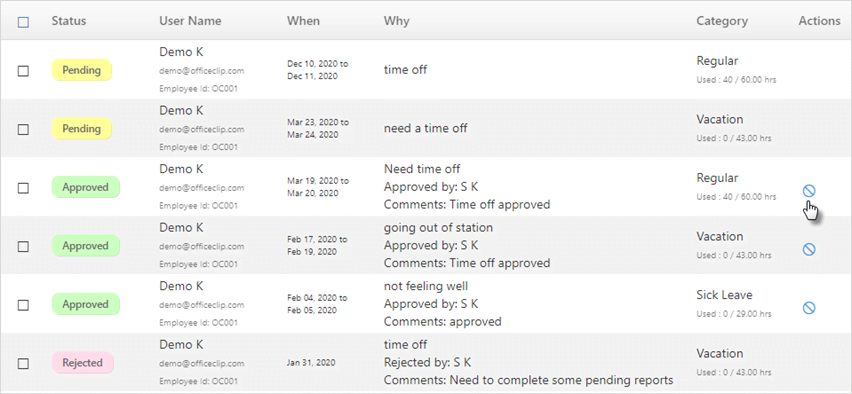Time Off Application
Understanding OfficeClip Time Off
Time Off's are paid time off's which the employee can utilize for vacations, medical reasons or personal reasons. Various time off categories can be created in OfficeClip time off module which will help to track these leaves and various policies can be created under these categories.
Overview
Time Off provides employees with a pool of bankable hours that can be used for any purpose. It is also know as Personal Time Off(PTO), which the employees can utilize for vacations, personal reasons, medical purpose etc. It is that period of that when employee is paid while taking leave from work.

OfficeClip's Time Off application tracks these vacations, sick days and other events associated with employees' time off from work.
It has the following features:
Shows all pending, approved and canceled time off in team calendar.
Allows managers and administrators to approve time off.
Tracks accruals for each employee across various types of paid time off.
Controls whether employees can mark time off on their time sheet before its approval.
History
The history button on the top right of the main screen helps to keep track of what your team is working at many levels.
When you click on the History button on the My requests screen, you will be able to see the history of time offs approved, submitted or rejected.
To learn more details about the history button, click here.
Time Off Accruals
An accrual is like a bank account for employee Time off. Time offs are accrued over a specified period and can be reset at the end of the period. Time off is specified in the employee agreement and usually increases with seniority.
Scenarios
Let's see some scenarios of how accruals work:
Rudy started his new job on June 15, 2010, and is allotted 12 vacation days per year. His vacation days are set to accrue on the first day of each month.
Let's assume Rudy's vacation days are not prorated, are calculated from his anniversary date, and the accrued days never expire.
On July 1, 2010, he has a total of 1 vacation day (for June; Rudy receives full 1 day as it is not prorated).
On Jan 1, 2011, he accumulated 7 vacation days (1 vacation day every month, June through December 2010), assuming he has not used any of them.
On Jan 1, 2012, he accumulated 19 vacation days (1 vacation day every month), assuming he has not used any of them.
Let's now assume Rudy's vacation days are prorated and calculated from his anniversary date, and only 5 vacation days can be carried over to the next year.
On July 1, 2010, he accrued 0.5 vacation days. (Because vacation is prorated, Rudy gets credit only for 15 days).
On July 1, 2011, he accrued 5.5 days of vacation, assuming he has not used any vacation time. (On June 16, 2011, he completed his anniversary; therefore only 5 vacation days are carried over, and from June 16, 2011, to July 1, 2011, he receives 0.5 days, totaling 5.5 days.)
Mary joins the company on May 15, 2010, and is given Personal Time Off of 15 days per year (1.25 per month). The PTO accrues every month, on the first of the month, and is reset every calendar year. Only 4 days may be carried forward to the next year, and PTO is not prorated.
On June 1, 2010, Mary accumulated 1.25 days of PTO (PTO is not prorated).
Assuming Mary has not used any the PTO throughout the year, on December 1, 2010, she accumulates 10 days (eight months at 1.25 days per month).
On January 1, 2011, her PTO accumulation would be reduced to 4 (Carry Forward Rule).
John gets 12 personal days every year starting January 1, 2010; days accrue on the first of each month. John has used up 4 vacation days in the first six months. John got a promotion after six months, which makes him eligible for 6 additional personal days every year.
On July 1, 2010, John would have 2 vacation days accrued (6 total vacation days with 4 used up).
Assuming John does not take any vacation in July, on August 1, 2010, his vacation days accrue to 3.5 days (2 previous days plus 1.5 days with the new accrual after his promotion)
